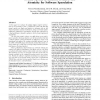Free Online Productivity Tools
i2Speak
i2Symbol
i2OCR
iTex2Img
iWeb2Print
iWeb2Shot
i2Type
iPdf2Split
iPdf2Merge
i2Bopomofo
i2Arabic
i2Style
i2Image
i2PDF
iLatex2Rtf
Sci2ools
115
click to vote
ASPLOS
2010
ACM
2010
ACM
A real system evaluation of hardware atomicity for software speculation
In this paper we evaluate the atomic region compiler abstraction by incorporating it into a commercial system. We find that atomic regions are simple and intuitive to integrate into an x86 binary-translation system. Furthermore, doing so trivially enables additional optimization opportunities beyond that achievable by a high-performance dynamic optimizer, which already implements superblocks. We show that atomic regions can suffer from severe performance penalties if misspeculations are left uncontrolled, but that a simple software control mechanism is sufficient to reign in all detrimental side-effects. We evaluate using full reference runs of the SPEC CPU2000 integer benchmarks and find that atomic regions enable up to a 9% (3% on average) improvement beyond the performance of a tuned product. These performance improvements are achieved without any negative side effects. Performance side effects such as code bloat are absent with atomic regions; in fact, static code size is reduc...
ASPLOS 2010 | Atomic Region Compiler | Atomic Regions | Programming Languages | Severe Performance Penalties |
Related Content
| Added | 28 May 2010 |
| Updated | 28 May 2010 |
| Type | Conference |
| Year | 2010 |
| Where | ASPLOS |
| Authors | Naveen Neelakantam, David R. Ditzel, Craig B. Zilles |
Comments (0)

